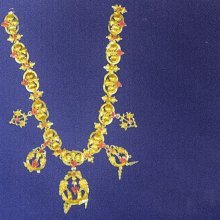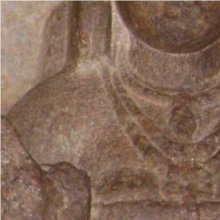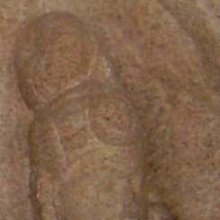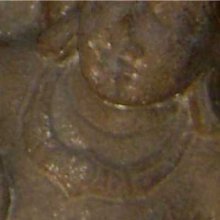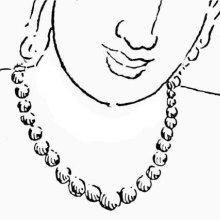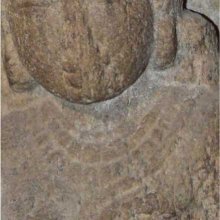Necklace: 2 definitions
Introduction:
Necklace means something in Hinduism, Sanskrit, the history of ancient India. If you want to know the exact meaning, history, etymology or English translation of this term then check out the descriptions on this page. Add your comment or reference to a book if you want to contribute to this summary article.
Images (photo gallery)
(+44 more images available)
In Hinduism
Natyashastra (theatrics and dramaturgy)
Source: Shodhganga: Elements of Art and Architecture in the Trtiyakhanda of the Visnudharmottarapurana (natya)The Necklace is associated with Kapittha-hasta: one of the twenty-two Single-hand Gestures (in Indian Dramas) (known as asaṃyuktahastas), according to the Viṣṇudharmottarapurāṇa, an ancient Sanskrit text which (being encyclopedic in nature) deals with a variety of cultural topics such as arts, architecture, music, grammar and astronomy.—In the Śabdakalpadruma, the word kapittha is explained as a kind of tree where kapi i.e., monkey comes due to the greed of fruit. The word kapittha again denotes the fruit called wood apple. [...] Apart from holding a garland and necklace, the Abhinayadarpaṇa also suggests the use of this posture to show the activities like picking flowers, offering betel leaves, preparing paste, applying perfumes etc.

Natyashastra (नाट्यशास्त्र, nāṭyaśāstra) refers to both the ancient Indian tradition (shastra) of performing arts, (natya—theatrics, drama, dance, music), as well as the name of a Sanskrit work dealing with these subjects. It also teaches the rules for composing Dramatic plays (nataka), construction and performance of Theater, and Poetic works (kavya).
India history and geography
Source: Singhi Jain Series: Ratnaprabha-suri’s Kuvalayamala-katha (history)Necklaces and (round earrings ornaments) were commonly found in the Sleeping chamber (of young ladies) in Ancient India, as depicted in the Kathās (narrative poems) such as Uddyotanasūri in his 8th-century Kuvalayamālā (a Prakrit Campū, similar to Kāvya poetry).—The Kuvalayamala (779 A.D.) is full of cultural material which gains in value because of the firm date of its composition. [...] Page 83.3-9: Here is the description of the house or the sleeping chambers of young ladies which were beautified for the reception of their husbands. The select items in this list are as follows: [e.g., putting on the śṛṅgāṭaka and valakkhala necklaces and round earrings ornaments;] [...]

The history of India traces the identification of countries, villages, towns and other regions of India, as well as mythology, zoology, royal dynasties, rulers, tribes, local festivities and traditions and regional languages. Ancient India enjoyed religious freedom and encourages the path of Dharma, a concept common to Buddhism, Hinduism, and Jainism.
See also (Relevant definitions)
Starts with: Necklace poplar, Necklace sedge.
Full-text (+1073): Kanthika, Hara, Lambusha, Kudupa, Ratnavali, Graiva, Uruhara, Nakshatramala, Vaijayantika, Gutsa, Urahsutrika, Malika, Ardhahara, Guccha, Hira, Harayashti, Shatayashtika, Manisara, Manimala, Mauktikavali.
Relevant text
Search found 181 books and stories containing Necklace; (plurals include: Necklaces). You can also click to the full overview containing English textual excerpts. Below are direct links for the most relevant articles:
Cosmetics, Costumes and Ornaments in Ancient India (by Remadevi. O.)
2.4. Neck Ornaments (d): Pearl Necklaces < [Chapter 3 - Ornaments]
2.4. Various other Neck Ornaments < [Chapter 3 - Ornaments]
2.4. Neck Ornaments (a): Hāra < [Chapter 3 - Ornaments]
Garga Samhita (English) (by Danavir Goswami)
Verse 5.21.42 < [Chapter 21 - The Story of Śrī Nārada]
Verses 2.17.4-9 < [Chapter 17 - The Meeting of Śrī Rādhā-Kṛṣṇa]
Verse 8.9.5 < [Chapter 9 - Lord Balarāma’s Rāsa Dance]
Pallava period (Social and Cultural History) (by S. Krishnamurthy)
Necklace (Hara) < [Chapter 4 - Material Culture of the People]
Neck Ornaments (Kanthabhushana) < [Chapter 4 - Material Culture of the People]
The cultural life of the Pre-Pallava Period < [Chapter 4 - Material Culture of the People]
Harshacharita (socio-cultural Study) (by Mrs. Nandita Sarmah)
14.2. Ornaments (Bhūṣā) < [Chapter 6 - Other Socio-Cultural Aspects]
Part 7: Revenue and Taxation < [Chapter 5 - Political Aspects]
3. Environmental Awareness in 7th century India < [Chapter 7 - Environmental awareness and Hygiene Conciousness]
Amarakoshodghatana of Kshirasvamin (study) (by A. Yamuna Devi)
Daily Life (2): Dress and Ornaments < [Chapter 3 - Social Aspects]
The backdrop of the Srikanthacarita and the Mankhakosa (by Dhrubajit Sarma)
Part 2 - Dress and decoration (found in the Śrīkaṇṭhacarita) < [Chapter IV - Socio-cultural study of the Śrīkaṇṭhacarita]
Part 6 - Kavisamaya or the poetic convention < [Chapter III - Literary Assessment Of The Śrīkaṇṭhacarita]
Part 5 - Śrīkaṇṭhacarita - Summary of contents < [Chapter II - The Śrīkaṇṭhacarita]
